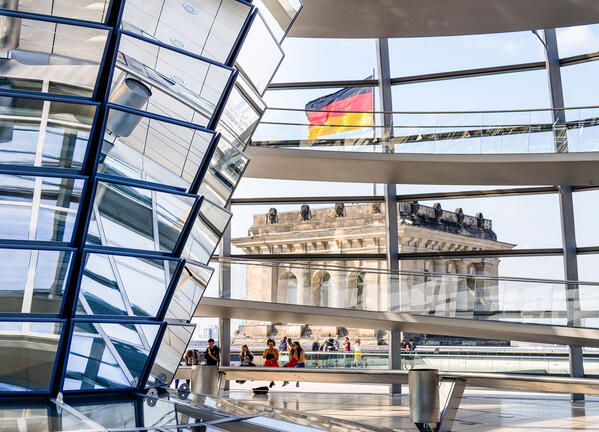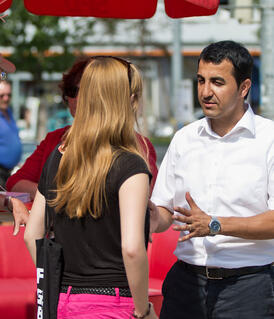2021 Federal parliament elections

The federal parliamentary elections Elections Every four years, the parties stand in the general elections to the Bundestag. Traditionally, the turn-out is high in Germany, and following a high in the 1970s, when the turn-out was over 90 percent, since reunification it has been around 80 percent. 76.6 per cent of eligible voters took part… Read more › held on 26 September 2021 brought about a change of government. Following the elections, the SPD, Alliance 90/the Greens and the FDP agreed to come together for the first time to form the Federal Government Federal Government The Federal Government and cabinet is made up of the Federal Chancellor and the Federal Ministers. While the Chancellor holds the power to issue directives, the ministers have departmental powers, meaning that they independently run their respective ministries in the framework of those directives… Read more › . Olaf Scholz of the SDP was elected Federal Chancellor Federal chancellor The Federal Chancellor is the only member of the Federal Government to be elected. The constitution empowers him to personally choose his ministers, who head the most important political authorities. Moreover it is the Chancellor who determines the number of ministries and their responsibilities… Read more › in December 2021. This brought Angela Merkel’s time in office to an end. Merkel of the CDU had been Federal Chancellor of Germany for 16 years.
There has never been a three-party coalition in Germany before. In past decades, Germany has almost always been governed by an alliance of two political parties Political parties According to the Basic Law it is the task of the political parties to participate in political will formation by the people. As such, putting forward candidates for political office and the organization of election campaigns both have the status of constitutional tasks. For this reason the parties… Read more › . Before the handover of power, the government was formed by the Christian Democratic Union (CDU) and the Christian Social Union (CSU) from Bavaria Bavaria The “beer state” of Bavaria also produces fine wine in the Franconia region. The Oktoberfest, Neuschwanstein Castle and the magnificent Alpine scenery attract more foreign tourists than does any other federal state. Yet the slogan “Laptop and Lederhose” demonstrates that there is more to Bavaria… Read more › – united in the Bundestag as the so-called "Union" – along with the Social Democratic Party of Germany (SPD). However, the outcome of the federal parliamentary elections prevented the formation of a conventional two-party coalition of this kind, giving rise to the new alliance of three parties.
The coalition agreement is entitled “Daring to make progress” and it forms the basis of the government’s work. In its foreign policy, the government is building on tried-and-tested keystones: its commitment to the European Union European Union In 1957, Germany was one of the six founding members of today’s EU, along with France, Italy, Belgium, the Netherlands and Luxembourg. The EU is currently made up of 27 states; the euro is the official currency in 20 of them. For Germany, European integration forms the basis for peace, security and… Read more › , its friendship with France, its partnership with the USA and its work to promote peace and reconciliation around the world. Another priority of this multilateral approach is to strengthen the United Nations United Nations The United Nations (UN) has a key role to play in the international system. Germany has been a UN member since 1973. Since joining, Germany has taken on more and more responsibility and is now one of the largest donors and supporters of the United Nations. For example, Germany is the second largest… Read more › politically, as well as expanding its staffing and funding. The governing coalition intends to be a leader in climate action. For example, by 2030 Germany is looking to produce 80% of its electricity from renewable sources. On an international level, the Federal Government aims to drive the energy transformation forward with measures including climate cooperation agreements. One of the government’s other key projects is the modernisation of immigration Immigration As early as the 19th century Germany attracted a large number of immigrants and since the 1950s has emerged as the European country with the largest immigrant population. In 1950, there were about 500,000 foreigners in Germany, accounting for a mere one percent or so of the population. This has… Read more › laws. The aim is to attract more skilled workers from abroad to come and work in Germany.
Results of the 2021 federal parliamentary elections

The Social Democratic Party of Germany (SPD) was the winner of the federal parliamentary elections Elections Every four years, the parties stand in the general elections to the Bundestag. Traditionally, the turn-out is high in Germany, and following a high in the 1970s, when the turn-out was over 90 percent, since reunification it has been around 80 percent. 76.6 per cent of eligible voters took part… Read more › held on 26 September 2021. It won 25.7% of the vote, putting it just ahead of the Union of the Christian Democratic Union of Germany (CDU) and the Christian Social Union from Bavaria Bavaria The “beer state” of Bavaria also produces fine wine in the Franconia region. The Oktoberfest, Neuschwanstein Castle and the magnificent Alpine scenery attract more foreign tourists than does any other federal state. Yet the slogan “Laptop and Lederhose” demonstrates that there is more to Bavaria… Read more › (CSU), which gained 24.1% of the vote. Also represented in the new Bundestag are Alliance 90/The Greens (14.8%), the Free Democratic Party (FDP, 11.5%) and the Alternative for Germany (AfD, 10.3%).
Turnout for Bundestag elections has dropped slightly in recent years. The highest turnout was for the 1972 election.

47 parties stood for election
A new Bundestag is elected every four years, as required by the Basic Law. There were 61.2 million eligible voters for the elections Elections Every four years, the parties stand in the general elections to the Bundestag. Traditionally, the turn-out is high in Germany, and following a high in the 1970s, when the turn-out was over 90 percent, since reunification it has been around 80 percent. 76.6 per cent of eligible voters took part… Read more › to the 20th Bundestag. Around 46.9 million people cast their votes, a turnout of 76.6%. This was slightly higher than the turnout for the 2017 elections, which was 76.2% Almost half of voters (47.3%) of voters cast their votes by post. This was the highest turnout for postal voting in German history.
Fifty-four parties were allowed to stand for election, having met the necessary requirements. Of those, 47 actually took part.
Germany’s demographic changes are evident in the electorate, where the proportion of older voters has increased substantially within 50 years.

Mixed-member proportional representation with first and second-choice votes
The Bundestag is elected according to the principle of mixed-member proportional representation. Voters can cast two votes. They use their first vote to choose a candidate from their constituency. Their second vote supports a party list, of Bundestag candidates. For a party to enter the Bundestag The Bundestag The Bundestag is made up of the elected representatives of the German people. In principle elections to the Bundestag are proportionally representative, with each party’s share of the vote in the election reflecting the number of seats it occupies in the parliament. But the electoral system also… Read more › , it must gain at least 5% of second votes (‘the 5% threshold’). It is also the case that if a party wins the direct mandate in three or more constituencies (i.e. that party’s local candidate gains most first votes) it is allowed to send representatives to the Bundestag.


